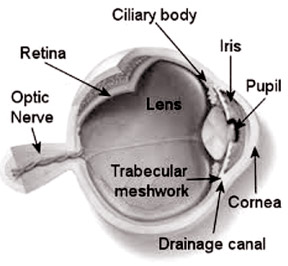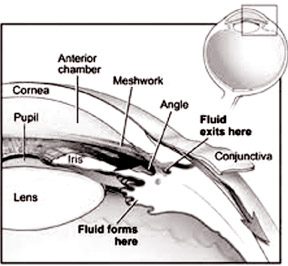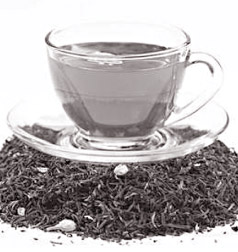|
Health Watch
World Glaucoma Week - March 11-17,2012:
Don't let glaucoma darken your life!
Dr. Madhuwanthi Dissanayake
Glaucoma is a potentially blinding eye condition. It refers to a
group of eye diseases which lead to progressive damage of the optic
nerve (the nerve that connects the eye to the brain). It is the second
leading cause of blindness in the world.
Glaucoma is a progressive optic neuropathy with characteristic
changes in the optic nerve head and corresponding loss of visual field
that is associated frequently but not invariably with a raised intra
ocular pressure (IOP). It encompasses so many different sub types which
have varied symptoms, pathophysiology and therefore treatment options.

Glaucoma is known to be the sneak thief of sight where undetected and
untreated patient ends up in blindness.
How does it come about?
The human eye is a fluid filled cavity where the volume is relatively
constant. The pressure with in the eye is maintained by a fluid within
the eye which is continuously being secreted and drained. It is called
the aquous humour. If due to any reason, this smooth passage of fluid is
disturbed, the pressure in the eye goes up. If it occurs suddenly the
pressure rise is acute and causes acute symptoms such as severe eye
pain. If the pressure rise is long standing it is symptomless, but the
optic nerve damage is progressing.
Symptoms
Symptoms depend on the subtype of glaucoma. In acute (sudden onset)
Glaucoma the main symptom is the eye pain. In chronic (Long standing)
glaucoma e.g. Primary open angle glaucoma, most of the patients are
symptomless.
Primary open angle glaucoma is a sub type that occurs more commonly
in the elderly. It is characterised by increase in intraocular pressure
(IOP < 21mmHg), an open drainage angle, glaucomatous optic nerve head
damage and visual field loss. The risk factors include Age (most after
65 years ), Race (common in black more than the white),Family history,
Myopia and Retinal diseases.
POAG is asymptomatic until a significant part of the visual field is
lost and hence the presentation is late.
On the contrary in acute angle closure glaucoma occurring commonly in
elderly female patients, the presentation is acute.
Starting as a slight blurring of vision sometimes with visualization
of halos( like rainbows),progressing to severe eye pain, redness and
difficulty of looking at light and reduced vision. Sometimes the patient
has severe headache, abdominal pain and vomiting that she may end up
getting admitted to a medical or a surgical ward than an eye ward.
This condition, if not detected and treated immediately, the acute
IOP rise will cause permanent optic nerve dame and irreversible
blindness.
Another fairly common sub type in Sri Lanka is the normotensive
(normal tension) glaucoma where the eye pressure is within normal limits
but with progressive optic nerve damage such as visual field defects.

Predisposing causes of glaucoma Genetic factors, congenital defects,
previous eye trauma, ocular inflammation, cataract, long term
uncontrolled diabetes and the use of steroid medications can be
associated with glaucoma.
Glaucoma is more common in diabetics. About 5 % of diabetics have
glaucoma. Mainly two types of glaucoma can affect the diabetic patients.
In one type (POAG) usually the patient is symptomless. Increased intra
ocular pressure damages the optic nerve leading to progressive visual
field loss.
The second type (neovascular glaucoma) occurs due to long term
uncontrolled diabetics.
Here the lack of blood supply to the inside of the eye (retina)
causes growing of new blood vessels in the iridocorneal angle. This
results in poor absorption of fluid from the eye. As a result the
pressure inside the eye will go up rapidly, leading to pain in the eye.
How to know whether you have glaucoma?
Since glaucoma is mostly a symptomless disease in the initial stages,
only an eye examination will help in the diagnosis. In the process of
the diagnosis your eye doctor will carry out several tests such as
measuring the intraocular pressure (IOP), visual field assessment (HVF),
and assessing the optic nerve (GDX).
As glaucoma is more common in diabetics it will be important to get
screened when you go for your annual eye examination for diabetic
retinopathy. If you have a family history of glaucoma or if you are
shortsighted it would be important to get screened annually specially if
you are over the age of 40 years.
Treatment options
In the assessment of the patient intraocular pressure (IOP),
assessment of visual field and gonioscopy to assess the drainage angle
are performed in addition to the routine visual acuity and refraction.
Treatment depends on the subtype and the options include topical
medications (eye drops),oral medications, laser treatment and surgery.
The main aim in the treatment is to minimize the progressive optic
nerve damage
This is mainly achieved by reducing the intra ocular pressure. This
can be done with oral tablets as well as eye drops. Taking the long term
usage into consideration, eye drops are at an advantage to minimize the
side effects.
There are different groups of eye drops ranging from once a day
administration to 3 times a day. Some can have side effects like redness
in the eye and darkening around the eyes.
Another eye drop (Timolol) should not be taken by patients with a
past history of asthmatic attacks.
Other treatment options are laser treatment and surgery in selected
cases.
Whatever the eye drop you are using it is very important to use it
regularly in the correct dosage as this will minimize the optic nerve
damage.
As glaucoma treatment should be continued long term the patient
should fully understand the importance of the continuous usage of
treatment.
As the patient does not feel any improvement or worsening, it is
important to monitor the disease with regular eye pressure checking and
visual field assessment etc.
The writer is a
Consultant Eye
Surgeon / Head,
Department of
Anatomy,
Faculty of Medicine, University of Colombo
A daily cup of tea, for a healthy heart and body
Studies have shown that a simple cup of tea can help improve heart
(cardiovascular) health. The secret is in a class of compounds called
flavonoids, found in your tea.
“The health benefits of tea are mainly derived from its antioxidant
properties. Studies all over the world have shown that tea is very rich
in a class of compounds called flavonoids. The most prominent effect of
flavonoids is its anti-oxidant properties. Anti-oxidants have been found
to reduce the risk of heart diseases, such as heart attacks,” said Dr
Tissa Amarakoon, a senior lecturer at the Department of Chemistry at the
University of Kelaniya and a former Deputy Director of the Tea Research
Institute of Sri Lanka.
 The anti-oxidant properties in flavonoids work by reducing the
oxidisation of fat molecules in our bodies, thereby reducing fat
deposits on walls of arteries that pump blood to the heart. This makes
tea a simple but effective defence against heart attacks. The anti-oxidant properties in flavonoids work by reducing the
oxidisation of fat molecules in our bodies, thereby reducing fat
deposits on walls of arteries that pump blood to the heart. This makes
tea a simple but effective defence against heart attacks.
Flavonoids also help in other ways. Many in vitro studies that
investigated the effects of flavonoids on relaxing isolated arteries,
have confirmed the vasodilatory effects of flavonoids derived from foods
such as wine, grape products, cocoa and tea.
These in vitro studies indicate that flavonoids help to increase
production of Nitrous Oxide (NO) that contributes towards the relaxation
of blood vessels. This, relaxation of blood vessels makes it easier for
the blood to flow through the body.
Studies have shown that black tea has a high percentage (82%) of
anti-oxidant flavonoids. The USDA database on flavonoids content in
selected foods (2003) , shows that black tea has the highest flavonoid
content out of foods such as apples, red onions, blue berries and dark
chocolate. Black tea also contributes 60%-84% of dietary flavonoids in
western populations.
However, the level of flavonoids in tea may change depending on the
cultivar, or the variety of the tea plant, and climatic and soil
factors. Leaf size of the tea, whether the tea is bagged or loose,
brewing time of the tea and brewing methods, may also have an impact.
The good news however, is that the anti-oxidant benefits of tea are not
shown to reduce when tea is consumed with milk and sugar. A good amount
of flavonoids could be detected in milked teas indicating that milk does
not cut down on the flavonoids present in tea due to chemical reactions.
Other studies have shown that tea can induce alertness, together with
calming properties. These properties are attributed to the two
compounds, caffeine and theanine, that are also found in tea.
“The caffeine in tea contributes to making a person more alert. A
substance called theanine, also found in tea, contributes to a calming
effect,” said Dr Amarakoon. However, caffeine content in tea is much
lower than in beverages such as coffee.
“Generally the content of caffeine in tea, is about half that of
coffee. In Sri Lankan tea for instance, the caffeine content in one cup
of tea is about 40 mgs, which is a very moderate intake,” explained Dr
Amarakoon.
Tea can also contribute to overall health because of its hydrating
properties. Contrary to some beliefs that tea can cause dehydration,
studies have shown that tea hydrates the body, which helps sustain the
body’s natural water balance. Because tea, on its own, without milk or
sugar, is a zero calorie beverage, substituting a cup of plain tea for
something heavier in calories, can also help you stay leaner, longer.
“In addition to its anti-oxidant properties, tea can also help in a
sensible and balanced weight loss programme because tea is a zero
calorie beverage. Consuming tea, without sugar, will make it a healthy
beverage that does not add to your daily caloric intake. Adding milk to
the tea will also not significantly reduce the benefits you get from
flavonoids, in terms of anti-oxidant properties,” explained Ms Sigrid de
Silva, a Senior Dietician, Nutrition Consultant and Lifestyle and
Wellness expert practicing in Sri Lanka.
How you consume your tea may have an impact on the overall benefits
derived from your cup of tea. However, in general, a plain, old
fashioned cup of tea, can be a low cost investment for long term good
health for you and your family.
Early diagnosis of Alzheimer’s Disease
|

Professor Ralph Martins |
Professor Ralph Martins, a recognised world leader of research into
Alzheimer’s disease will deliver a public lecture on ‘Early diagnosis
and prevention’ on March 15 at 6 pm at the Lanka Alzheimer’s Foundation
auditorium at 110 Ketawalamulla Lane, Colombo 10.
Since the disease’s discovery in 1906, little research work was done
until Professor Martins teamed up with Professor Colin Masters and a
team of German scientists. They made the first significant discovery
showing that the beta amyloid protein that coats the brain is the
foundation of Alzheimer’s.
Later Professor Martins made the critical discovery that the
Alzheimer’s brain is under oxidative stress. He has been instrumental in
new technology that makes it possible to determine if a patient has
deposits of the toxic beta amyloid, and therefore allow early treatment
before the brain has been irreparably damaged.
As head of the Sir James McCusker Unit for Alzheimer’s Disease
Research for over 20 years, and Inaugural Chair for Ageing and
Alzheimer's Disease at Edith Cowan University, Professor Martins is
working to develop an early diagnostic blood test.
How much iodine is too much?
Amy Norton
A new study looks at excess iodine intake: how much is too much
iodine? Excessive iodine in the diet can cause sub clinical
hypothyroidism, which has been linked with heart disease.
New York- Iodine deficiency is a major health problem worldwide, but
a new study points to the potential downsides of too much iodine.
|

Less is known about how much iodine is too much |
Iodine is a mineral found in iodized salt, seafood, eggs, dairy and
some breads. It is used by the thyroid gland to help regulate metabolism
and development, especially in babies and children.
Iodine deficiency during fetal and early-childhood development is a
leading cause of brain impairments in much of the world. So most
research has been directed at the effects of inadequate iodine.
Less is known about how much iodine is too much. So for the new
study, reported in the American Journal of Clinical Nutrition, Chinese
researchers randomly assigned healthy adults to take various doses of
iodine supplements for four weeks.
They found that at relatively higher doses -- 400 micrograms a day
and up -- study participants began developing what's called subclinical
hypothyroidism.
That refers to a dip in the body's thyroid hormone levels, but with
no obvious symptoms of hypothyroidism -- which include problems like
fatigue, depression, dry skin and weight gain.
In this study, people taking 400-microgram supplements were getting
around 800 micrograms of iodine per day when diet was factored in.
So the findings suggest that people -- at least in China -- should
get no more than 800 micrograms a day, according to the researchers, led
by Wanqi Zhang of Tianjin Medical University.
That's different from what's recommended in the U.S., where National
Institutes of Health guidelines say the safe upper limit for adults is
1,100 micrograms of iodine per day.
Still, the typical American would get much less than 800 micrograms
of iodine a day through diet anyway, according to Dr. Elizabeth Pearce,
an associate professor of medicine at Boston University who was not
involved in the study.
That said, Pearce cautioned against taking iodine supplements with
more than 150 micrograms in a daily dose. And most Americans could skip
supplements altogether.
“Overall, we're iodine-sufficient,” said Pearce, who studies iodine
sufficiency and thyroid function.
But she said there are certain people who may need supplements,
including pregnant women.
In the U.S., adults are advised to get 150 micrograms of iodine each
day; pregnant women should get 220 micrograms, while breastfeeding moms
are told to get 290 micrograms.
The American Thyroid Association recommends that pregnant and
breastfeeding women take a vitamin with iodine because low iodine can
increase the risk of miscarriage and thyroid problems in moms, in
addition to mental disabilities in babies.
According to Pearce, vegans may also want to take a supplement. In a
recent study, Pearce and her colleagues found that the average iodine
level in a group of 63 vegans was lower than what's recommended --
though their thyroid hormone levels were in the normal range.
Vegans eschew all animal products, including dairy and eggs, so their
iodine sources may be few.
The current findings are based on 256 healthy adults who had normal
thyroid when they entered the study. Zhang's team, which did not respond
to requests for comment, randomly assigned them to take one of 12 doses
of supplemental iodine -- anywhere from 0 to 2,000 micrograms per day,
for four weeks.
Of the people who took 400 micrograms, 5 percent developed
subclinical hypothyroidism. And the numbers rose in tandem with the
iodine dose: Of people on the highest dose (2,000 micrograms per day),
47 percent developed subclinical hypothyroidism.
“These are interesting data,” Pearce said, “because we don't have a
lot of information on iodine excess.”
Subclinical hypothyroidism has no obvious symptoms, but studies have
linked it to an increased risk of heart disease over the long term,
Pearce noted.
Those studies don't prove that subclinical hypothyroidism is to
blame. Still, they raise concerns that there could be health
consequences.
But in general, Pearce said, it's thought that the effects of your
iodine intake may depend on “who you are and where you live.”
In certain parts of the world, the soil is low in iodine, and people
who eat mainly local foods have a high risk of deficiency. In other
parts of the world -- Japan, for example -- people have a high iodine
intake starting early in life, and they seem to “tolerate” that high
level, Pearce explained.
In China, natural iodine levels vary by region. The country
introduced universal salt iodization in 1996, so the problem of iodine
deficiency has been controlled in most areas.
But Pearce said it's not clear if the adults in this study had
adequate iodine intake early in life. If not, that could be a factor in
their response to iodine supplements.
(Reuters)
Negative effects of air conditioners
L.S.R. Balachandran
At present practically all offices and even wealthy bungalows are air
conditioned. People should be aware of the health hazards faced by them
if they stay continuously in air conditioned rooms for more than 12
hours.
Your skin will get dry. During summer season it is always better to
perspirate more which in turn keep your skin cool and it is healthy.
Those who have skin diseases should not wait in air-conditioned rooms
for long.
Intake of water every hour is compulsory.
It is better to leave the A/C rooms after usage of 3 hours. Even at
night it is better to stop usage every one hour. |



